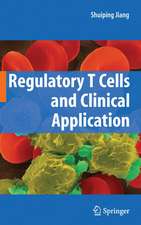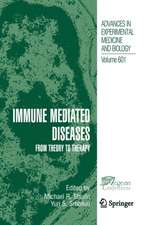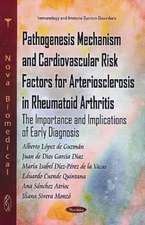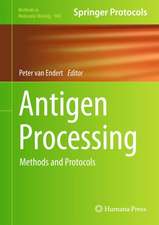T Regulatory Cells in Human Health and Diseases: Advances in Experimental Medicine and Biology, cartea 1278
Editat de Song-Guo Zhengen Limba Engleză Paperback – 3 feb 2022
The beginning chapters provide a useful contemporary classification of Treg cell populations and then progress to chapters that explore basic mechanisms of Treg cell function and epigenetic control. In addition to descriptions of typical CD4+ Foxp3+ cells, other chapters provide detailed presentations of Treg subsets such as CD8+ Tregs and IL-10-producing Tr1 cells. The differences of various Treg subsets, as well as circulating and resident Treg cell populations, are next compared. Importantly, the next chapters provide the clinical correlation of Treg cells with autoimmune diseases, inflammatory diseases, metabolic diseases, cancer and organ transplantation and progress to chapters that highlight emerging innovative technology including nanoparticle-Treg cells and their translational values. In summary, the book will provide a valuable resource not only for graduate students and researchers in the fields of immunology, cell biology and translational medicine but also for all others interested in learning more about Treg cells and their application in human health and disease.
| Toate formatele și edițiile | Preț | Express |
|---|---|---|
| Paperback (1) | 1185.74 lei 38-44 zile | |
| Springer Nature Singapore – 3 feb 2022 | 1185.74 lei 38-44 zile | |
| Hardback (1) | 1199.08 lei 38-44 zile | |
| Springer Nature Singapore – 2 feb 2021 | 1199.08 lei 38-44 zile |
Din seria Advances in Experimental Medicine and Biology
- 9%
 Preț: 719.60 lei
Preț: 719.60 lei - 20%
 Preț: 691.93 lei
Preț: 691.93 lei - 5%
 Preț: 717.00 lei
Preț: 717.00 lei - 5%
 Preț: 716.28 lei
Preț: 716.28 lei - 5%
 Preț: 717.20 lei
Preț: 717.20 lei - 15%
 Preț: 640.24 lei
Preț: 640.24 lei - 5%
 Preț: 1113.83 lei
Preț: 1113.83 lei - 5%
 Preț: 715.71 lei
Preț: 715.71 lei - 5%
 Preț: 820.43 lei
Preț: 820.43 lei - 15%
 Preț: 641.38 lei
Preț: 641.38 lei - 5%
 Preț: 716.28 lei
Preț: 716.28 lei - 5%
 Preț: 523.99 lei
Preț: 523.99 lei - 5%
 Preț: 1031.00 lei
Preț: 1031.00 lei - 5%
 Preț: 717.00 lei
Preț: 717.00 lei - 5%
 Preț: 715.35 lei
Preț: 715.35 lei - 20%
 Preț: 1161.71 lei
Preț: 1161.71 lei - 5%
 Preț: 1170.51 lei
Preț: 1170.51 lei - 18%
 Preț: 1119.87 lei
Preț: 1119.87 lei - 5%
 Preț: 1288.48 lei
Preț: 1288.48 lei - 5%
 Preț: 1164.67 lei
Preț: 1164.67 lei - 5%
 Preț: 1101.73 lei
Preț: 1101.73 lei - 18%
 Preț: 1123.67 lei
Preț: 1123.67 lei - 5%
 Preț: 1435.64 lei
Preț: 1435.64 lei - 20%
 Preț: 1044.10 lei
Preț: 1044.10 lei - 18%
 Preț: 946.39 lei
Preț: 946.39 lei - 5%
 Preț: 292.57 lei
Preț: 292.57 lei - 18%
 Preț: 957.62 lei
Preț: 957.62 lei - 18%
 Preț: 1235.76 lei
Preț: 1235.76 lei - 5%
 Preț: 1231.55 lei
Preț: 1231.55 lei - 5%
 Preț: 1292.30 lei
Preț: 1292.30 lei - 5%
 Preț: 1102.10 lei
Preț: 1102.10 lei - 18%
 Preț: 1132.81 lei
Preț: 1132.81 lei - 5%
 Preț: 1165.19 lei
Preț: 1165.19 lei - 5%
 Preț: 1418.48 lei
Preț: 1418.48 lei - 5%
 Preț: 1305.63 lei
Preț: 1305.63 lei - 18%
 Preț: 1417.72 lei
Preț: 1417.72 lei - 18%
 Preț: 1412.99 lei
Preț: 1412.99 lei - 24%
 Preț: 806.16 lei
Preț: 806.16 lei - 18%
 Preț: 1243.29 lei
Preț: 1243.29 lei - 5%
 Preț: 1429.44 lei
Preț: 1429.44 lei - 5%
 Preț: 1618.70 lei
Preț: 1618.70 lei - 5%
 Preț: 1305.12 lei
Preț: 1305.12 lei - 18%
 Preț: 1124.92 lei
Preț: 1124.92 lei - 5%
 Preț: 1097.54 lei
Preț: 1097.54 lei - 15%
 Preț: 649.87 lei
Preț: 649.87 lei - 5%
 Preț: 1097.54 lei
Preț: 1097.54 lei - 18%
 Preț: 945.79 lei
Preț: 945.79 lei - 5%
 Preț: 1123.16 lei
Preț: 1123.16 lei
Preț: 1185.74 lei
Preț vechi: 1248.16 lei
-5% Nou
Puncte Express: 1779
Preț estimativ în valută:
226.92€ • 236.03$ • 187.34£
226.92€ • 236.03$ • 187.34£
Carte tipărită la comandă
Livrare economică 10-16 aprilie
Preluare comenzi: 021 569.72.76
Specificații
ISBN-13: 9789811564093
ISBN-10: 9811564094
Pagini: 302
Ilustrații: X, 302 p. 35 illus., 31 illus. in color.
Dimensiuni: 178 x 254 mm
Greutate: 0.64 kg
Ediția:1st ed. 2021
Editura: Springer Nature Singapore
Colecția Springer
Seria Advances in Experimental Medicine and Biology
Locul publicării:Singapore, Singapore
ISBN-10: 9811564094
Pagini: 302
Ilustrații: X, 302 p. 35 illus., 31 illus. in color.
Dimensiuni: 178 x 254 mm
Greutate: 0.64 kg
Ediția:1st ed. 2021
Editura: Springer Nature Singapore
Colecția Springer
Seria Advances in Experimental Medicine and Biology
Locul publicării:Singapore, Singapore
Cuprins
1 Regulatory T cells: Concept, Classification, Phenotype and Biological Characteristics
2 A structure-guided delineation of FOXP3 regulation mechanism in IPEX
3 Regulation of Treg functions by the ubiquitin pathway
4 Ubiquitin-dependent regulation of Treg Function and Plasticity
5 Metabolic Choice Tunes Foxp3+ Regulatory T Cells Function
6 Treg Cells and Epigenetic Regulation
7 TCR/ITK signaling in Type 1 regulatory T cells
8 Adipose Tissue T Regulatory Cells: Implications for Health and Disease
9 Intestinal Regulatory T cells
10 The association of gut microbiota and Treg-dysfunction in autoimmune diseases
11 Treg Cells in Autoimmune Uveitis
12 Understanding andtargeting human cancer regulatory T cells to improve therapy
13 TNF-TNFR2 Signal plays a decisive role in the activation of CD4+Foxp3+ regulatory T cells: implications in the treatment of autoimmune diseases and cancer
14 The pursuit of regulatory T cells in the induction of transplant tolerance
15 Regulatory T cells for induction transplantation tolerance
2 A structure-guided delineation of FOXP3 regulation mechanism in IPEX
3 Regulation of Treg functions by the ubiquitin pathway
4 Ubiquitin-dependent regulation of Treg Function and Plasticity
5 Metabolic Choice Tunes Foxp3+ Regulatory T Cells Function
6 Treg Cells and Epigenetic Regulation
7 TCR/ITK signaling in Type 1 regulatory T cells
8 Adipose Tissue T Regulatory Cells: Implications for Health and Disease
9 Intestinal Regulatory T cells
10 The association of gut microbiota and Treg-dysfunction in autoimmune diseases
11 Treg Cells in Autoimmune Uveitis
12 Understanding andtargeting human cancer regulatory T cells to improve therapy
13 TNF-TNFR2 Signal plays a decisive role in the activation of CD4+Foxp3+ regulatory T cells: implications in the treatment of autoimmune diseases and cancer
14 The pursuit of regulatory T cells in the induction of transplant tolerance
15 Regulatory T cells for induction transplantation tolerance
Notă biografică
Dr. Song-Guo Zheng is Ronald L. Whisler Chair in Immunology and Rheumatology, Professor of Internal Medicine of Ohio State University College of Medicine, USA. He is also the director of the Department of Clinical Immunology, Third Hospital affiliated to Sun Yat-sen University, China. He serves as the EiC of American Journal of Clinical and Experimental Immunology, Associate Editor of Frontiers in Immunology, and the editorial board member of several international peer-reviewed journals, such as Cytokine & Growth Factor Reviews and Cellular and Molecular Immunology. Dr. Zheng’s research group is investigating the properties of regulatory T cells (Tregs), and their role in the maintenance of immune tolerance and prevention of autoimmune diseases. He has published over 100 articles on international journals in this field.
Textul de pe ultima copertă
This book addresses one of the major challenges of immunology today that is being directed to the translation of the rapidly emerging volume of basic science contributions of immunology to clinical medicine. In so doing, the book systemically introduces and discusses concepts, classifications, phenotypic and functional descriptions of regulatory T (Treg) cells in health and disease. The authors of the 15 chapters were selected from among the most qualified experts in the field of Treg cell research who provide a comprehensive overview of Treg cells and their biology in the ensuing chapters.
The beginning chapters provide a useful contemporary classification of Treg cell populations and then progress to chapters that explore basic mechanisms of Treg cell function and epigenetic control. In addition to descriptions of typical CD4+ Foxp3+ cells, other chapters provide detailed presentations of Treg subsets such as CD8+ Tregs and IL-10-producing Tr1 cells. The differences of various Treg subsets, as well as circulating and resident Treg cell populations, are next compared. Importantly, the next chapters provide the clinical correlation of Treg cells with autoimmune diseases, inflammatory diseases, metabolic diseases, cancer and organ transplantation and progress to chapters that highlight emerging innovative technology including nanoparticle-Treg cells and their translational values. In summary, the book will provide a valuable resource not only for graduate students and researchers in the fields of immunology, cell biology and translational medicine but also for all others interested in learning more about Treg cells and their application in human health and disease.
The beginning chapters provide a useful contemporary classification of Treg cell populations and then progress to chapters that explore basic mechanisms of Treg cell function and epigenetic control. In addition to descriptions of typical CD4+ Foxp3+ cells, other chapters provide detailed presentations of Treg subsets such as CD8+ Tregs and IL-10-producing Tr1 cells. The differences of various Treg subsets, as well as circulating and resident Treg cell populations, are next compared. Importantly, the next chapters provide the clinical correlation of Treg cells with autoimmune diseases, inflammatory diseases, metabolic diseases, cancer and organ transplantation and progress to chapters that highlight emerging innovative technology including nanoparticle-Treg cells and their translational values. In summary, the book will provide a valuable resource not only for graduate students and researchers in the fields of immunology, cell biology and translational medicine but also for all others interested in learning more about Treg cells and their application in human health and disease.
Caracteristici
Systematically providing readers with cutting-edge developments in Treg research Introducing the biology of Treg cells and their functions in diseases Discussing the manipulation of Treg in clinical therapy























